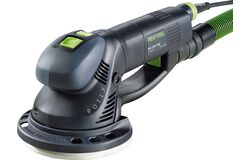Guide to sanding old paint and varnish and preparing surfaces for new coatings

Description
The ROTEX geared eccentric sanders can be used to prepare surfaces for subsequent coatings by switching between coarse and fine sanding.
When refurbishing old windows or doors, in particular, the ROTEX enables fast, efficient removal of old paint and varnish.
Tools/accessories
Alternative tools
Procedure
-
Fix Granat P60 abrasive to the sanding pad.
Connect the ROTEX to the mobile dust extractor.
Switch the tool to coarse sanding. Coarse sanding allows you to remove the paint quickly and efficiently.
Set the speed to level 6.
-
Guide the tool slowly over the surface in order to remove the damaged coating.
Use the Granat sanding discs with grit from P80 to P120 to sand the surface again in the coarse sanding step.
-
To produce a surface that is ready for primer, use the switch to set the ROTEX to fine sanding.
Use the Granat P150 and P180 sanding discs to finish sanding the surface.
The final grit range depends on the coating material to be applied. Once the paint has been removed and the surface has been dusted clean, you can begin applying primer or an undercoat to the surface.
-
Our illustrated guides and work results are documented working steps that we have performed in practice. They are individual examples and do not guarantee or promise that users will obtain the same results. The results will depend on the user's experience and skill, as well as the material being used. Illustrated guides do not replace any Festool operating manuals and/or safety instructions. Liability for ensuring that the information, instructions and applications are free from content defects and defects of title, in particular with regard to the absence of defects, correctness, freedom from third party intellectual property rights and copyrights, completeness and fitness for purpose, is excluded. Claims for damages made by the user, regardless of their legal basis, are excluded. These liability exclusions are not applicable if the damage was intentional or caused by gross negligence, or in cases of statutory liability.
We cannot accept liability for damage resulting from defects.↑









































